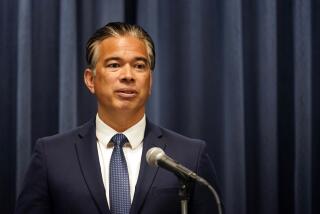Taking the bankers to court

A new lawsuit against Bank of America illuminates the warped incentives that helped inflate the housing bubble and contributed to its calamitous collapse. Filed last week by the U.S. attorney in Manhattan, it focuses on allegations that Countrywide Financial Corp. (which Bank of America bought in 2008) pumped up the volume of loans it issued and then sold to Fannie Mae and Freddie Mac, regardless of their suspect quality.
Manhattan U.S. Atty. Preet Bharara contends that Countrywide and Bank of America “cast aside underwriters, eliminated quality controls, incentivized unqualified personnel to cut corners and concealed the resulting defects” when they peddled the loans to Fannie and Freddie. The result, the government asserts, was more than $1 billion in losses at those two institutions, whose shortfalls are now covered by the taxpayers. Bank of America hasn’t denied the allegations about shoddy underwriting but insists that it has repurchased all the bad loans that Fannie and Freddie have asked it to take back.
Bharara’s office has filed similar suits against Wells Fargo and four other banks for allegedly making loans recklessly, then fraudulently claiming guarantees for them from the Federal Housing Administration. The case against Wells Fargo is pending; the other four banks settled earlier this year.
Partisans can argue whether the government pressured banks to make risky loans in order to put homeownership within reach of more Americans. What’s inarguable is that the system was ripe for abuse. Banks collected fees for every mortgage they issued, and they minimized their risks by offloading the loans to investors (such as Fannie and Freddie) or obtaining FHA guarantees. Significantly, Fannie, Freddie and the FHA relied on lenders’ certifications about the loans’ quality; they didn’t examine the loans they bought or guaranteed to make sure they complied with their standards unless and until the borrower defaulted.
Rising property values made it less important for lenders to care about the quality of their loans because troubled borrowers could be rescued by refinancing their loans or selling their homes. It was only after prices began to tumble in 2007 that the system started coming apart. Nevertheless, the staggering number of defaults — even of supposedly safe “prime” mortgages — lends credibility to the theory that banks deliberately made loans they knew could not be repaid if the housing market’s unsustainable rise came to an end. The scrutiny that the Justice Department is applying to banks’ underwriting practices and their effect on Fannie, Freddie and the FHA is welcome. Taxpayers should not be forced to pay for the losses caused by banks’ strategic disregard for the quality of their loans.
More to Read
A cure for the common opinion
Get thought-provoking perspectives with our weekly newsletter.
You may occasionally receive promotional content from the Los Angeles Times.










